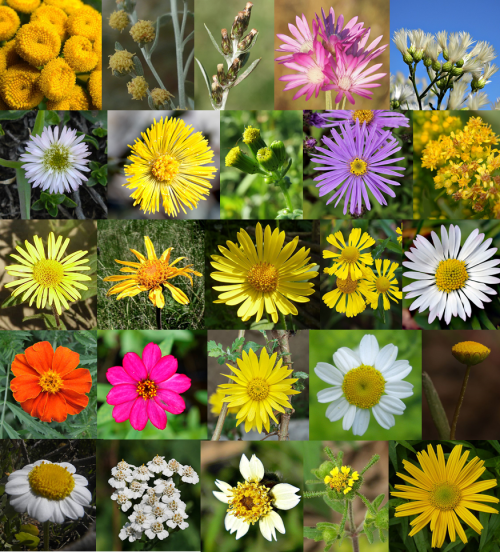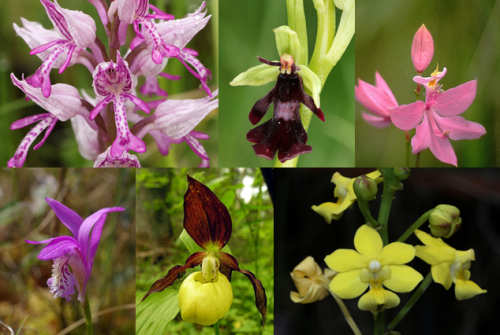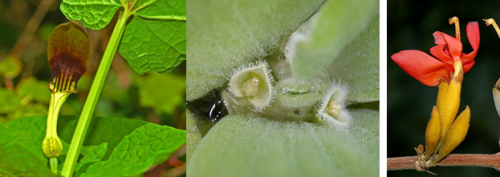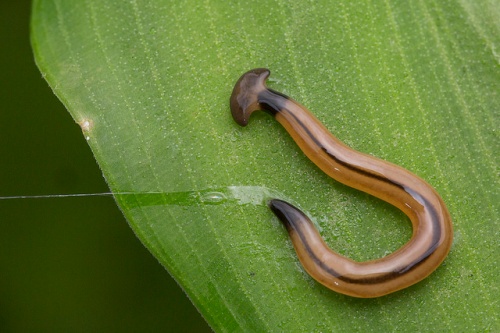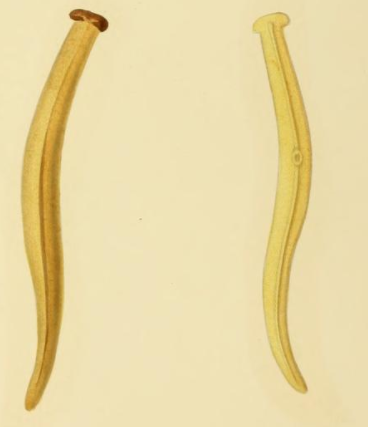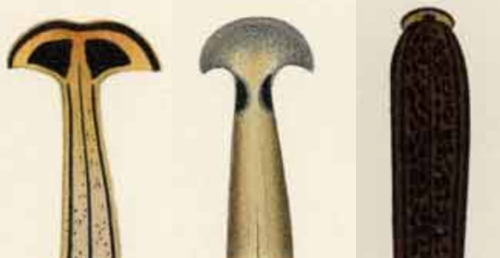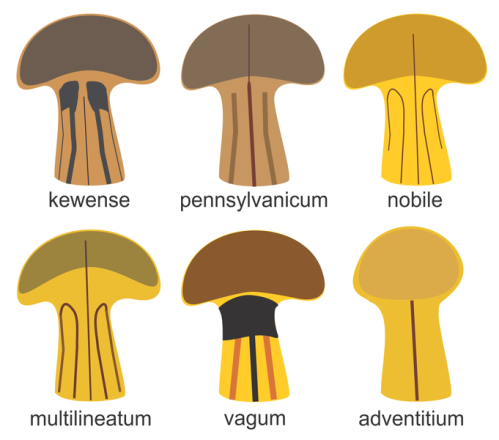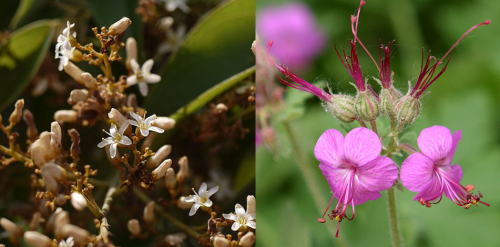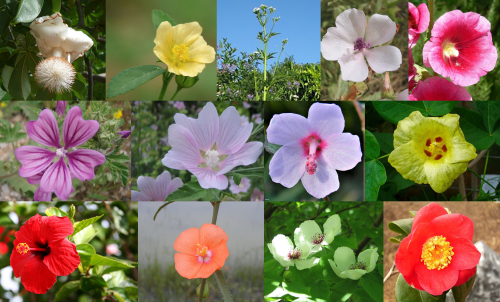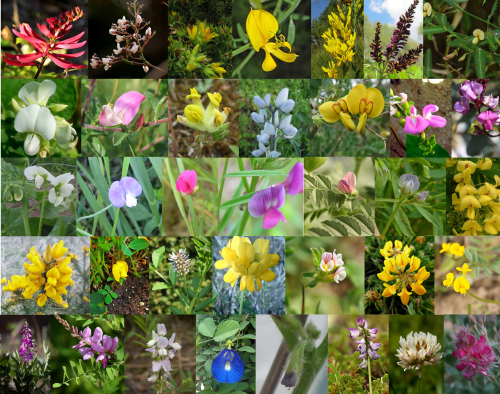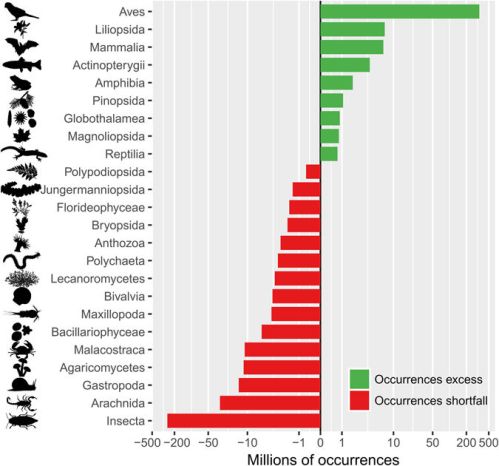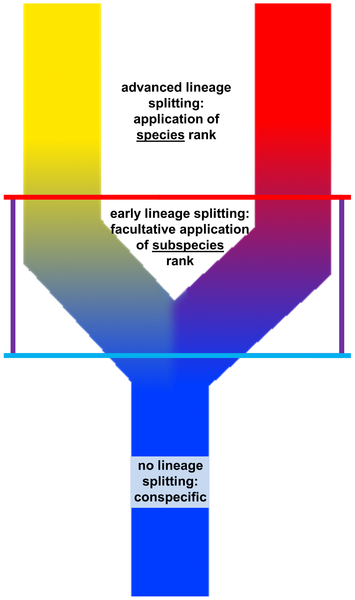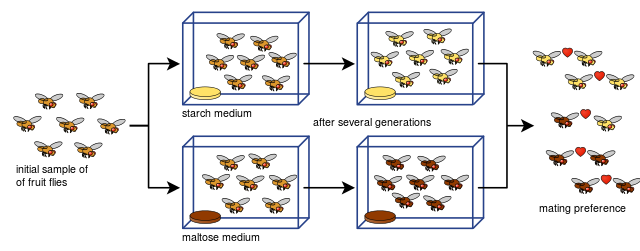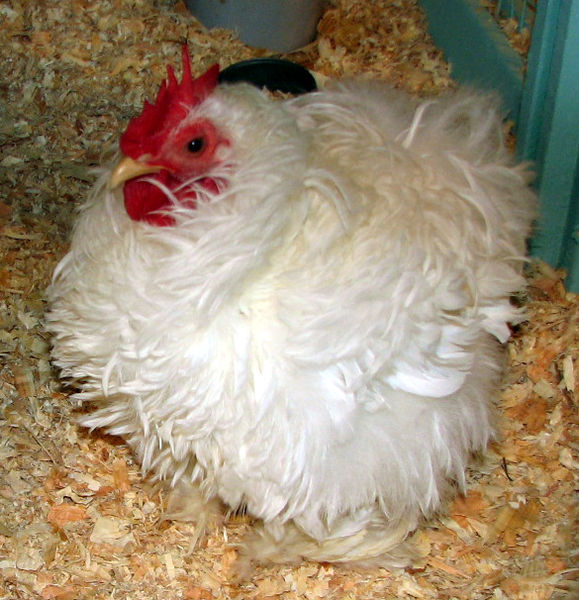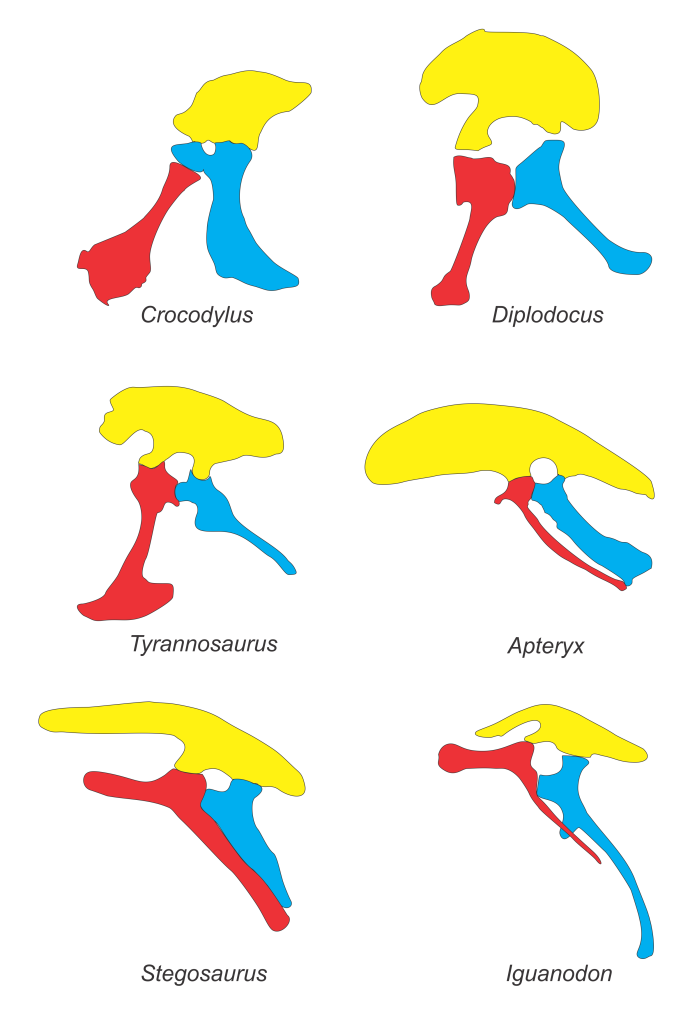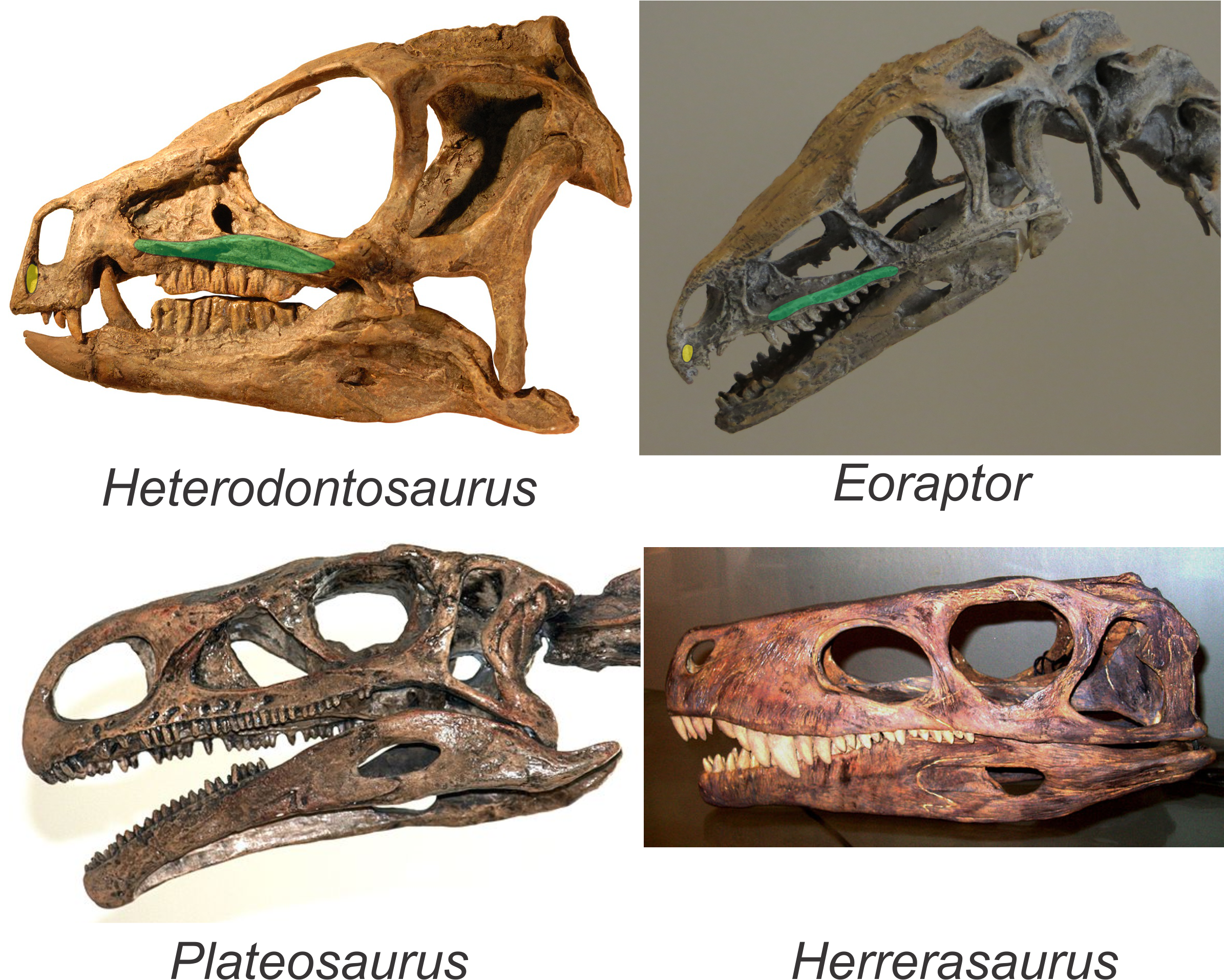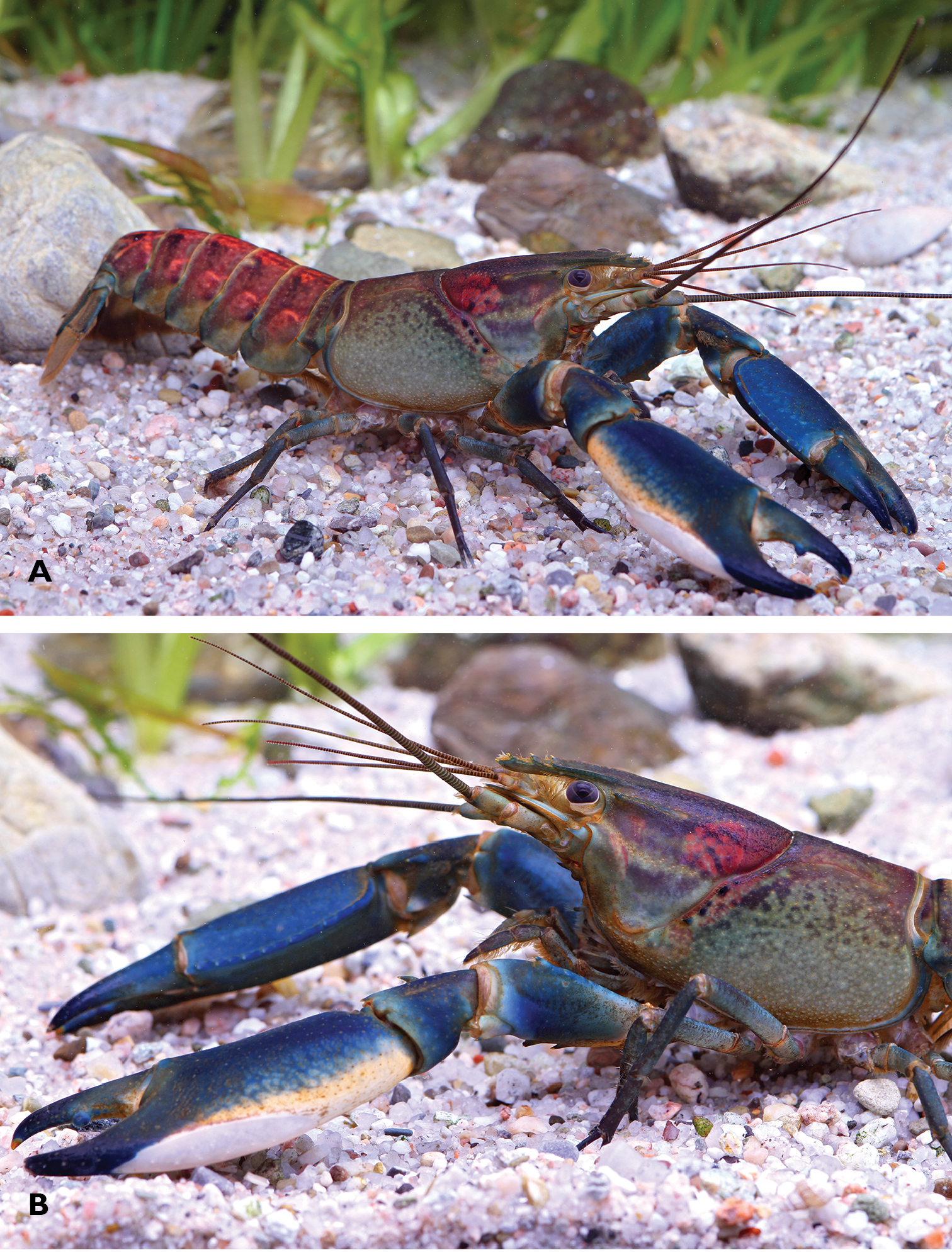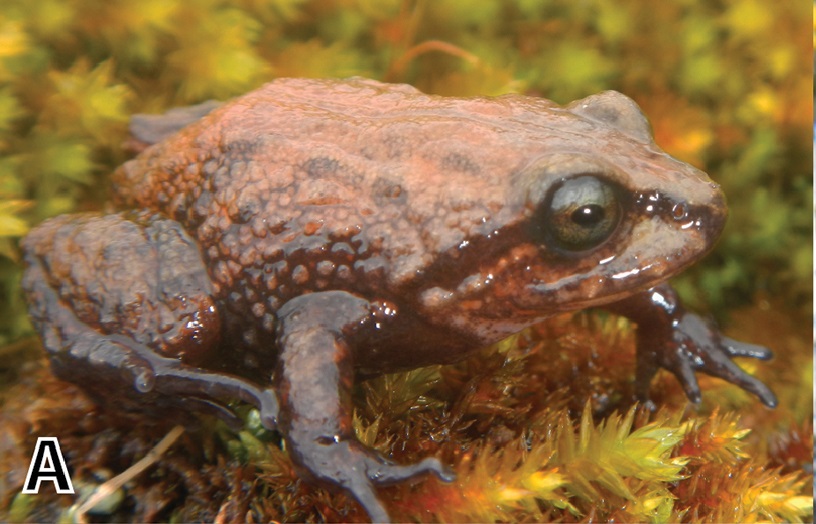by Piter Kehoma Boll
This is the last part of Linnaeus’ classification of plants dealing with flowering plants (see parts 1, 2, 3, 4, 5, 6 and 7) and presents three classes composed by plants that contain more than one type of flower. The last part of the system (part 9) will deal with non-flowering plants.
21. Monoecia (“single house”)
“Husbands inhabit with women in the same house, but in different bedroom”, i.e., male and female organs occur in the same plant, but in different flowers.
21.1 Monoecia Monandria (“single house, single male”), male flowers having a single stamen: Zannichellia (horned pondweeds), Ceratocarpus (hornfruits), Hippomane (manchineels), Cynomorium (desert thumb).
21.2 Monoecia Diandria (“single house, two males”), male flowers having two stamens: Lemna (duckweeds).

The horned pondweed (Zannichellia palustris, left), the manchineel tree (Hippomane mancinella, center-left) and the desert thumb (Cynomorium coccineum, center-right) were classified in the order Monoecia Monandria, while the common duckweed (Lemna minor, right) was classified in the order Monoecia Diandria. Credits to Yu Ito (horned pondweed), Hans Hillewaert (manchineel, desert thumb) and Wikimedia user 3268zauber (duckweed).
21.3 Monoecia Triandria (“single house, three males”), male flowers having three stamens: Typha (cattails or bulrushes), Sparganium (bur-reeds), Zea (maize), Tripsacum (gamagrasses), Coix (Job’s tear), Olyra (carrycillo), Carex (true sedges), Axyris (pigweeds), Omphalea (cobnuts), Tragia (noseburns), Hernandia (hernandias), Phyllanthus (chamber bitters, Indian gooseberries and alike).
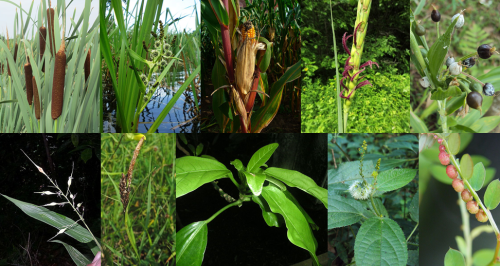
The order Monoecia Triandria included (from left to right, top to bottom) the common cattail (Typha latifolia), branched bur-reed (Sparganium erectum), maize (Zea mays), eastern gamagrass (Tripsacum dactyloides), Job’s tear (Coix lacryma-jobi), carrycillo (Olyra latifolia), carnation-sedge (Carex panicea), Jamaican cobnut (Omphalea triandra), Indian noseburn (Tragia involucrata) and chamber bitter (Phyllanthus urinaria). Credits to H. Zell (maize), Mason Brock (gamagrass), Alex Popovkin (carrycillo), Kristian Peters (sedge), and Wikimedia users AnRo0002 (cattail), Hugo.arg (bur-reed), Vinayaraj (Job’s tear, Indian noseburn), Carstor (cobnut) and Atsuko-y (chamber bitter).
21.4 Monoecia Tetrandria (“single house, four males”), male flowers with four stamens: Betula (birches and alders), Buxus (box), Urtica (nettles), Morus (mulberry trees).

The dwarf birch (Betula nana, left), the common box (Buxus sempervirens, center-left), the common nettle (Urtica dioica, center-right) and the black mulberry tree (Morus nigra, right) were classified in the order Monoecia Tetrandria. Credits to Uwe H. Friese (nettle), Fritz Geller-Grimm (mulberry tree) and Wikimedia users El Grafo (birch) and Abrimaal (box).
21.5 Monoecia Pentandria (“single house, five males”), male flowers with five stamens: Xanthium (cockleburs), Ambrosia (ragweeds), Parthenium (feverfews), Iva (marsh elders), Amarantus (pigweeds).

The common cocklebur (Xanthium strumarium, left), the common ragweed (Ambrosia artemisiifolia, center-left), the American feverfew (Parthenium integrifolium, center), the annual marsh elder (Iva annua, center-right) and the spiny pigweed (Amaranthus spinosus, right) were part of the order Monoecia Pentandria. Credits to Javier Martin (cocklebur), Meneerke Bloem (ragweed), Krzysztof Ziarnek (feverfew), and Forest & Kim Starr (pigweed).
21.6 Monoecia Hexandria (“single house, six males”), male flowers with six stamens: Zizania (wild rice), Pharus (stalkgrass), Solandra (a species of doubtful identifcation).
21.7 Monoecia Heptandria (“single house, seven males”), male flowers with seven stamens: Guettarda (beach gardenia).
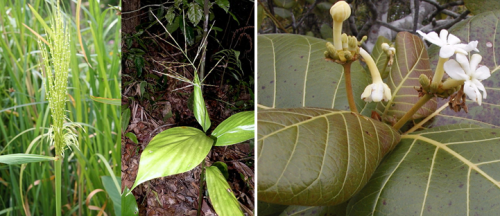
The wild rice (Zizania aquatica, left) and the broadleaf stalkgrass (Pharus latifolius, center) were placed in the order Monoecia Hexandria, while the beach gardenia (Guettarda speciosa) was in the order Monoecia Heptandria. Credits to Michael Wolf (wild rice), Alex Popovkin (stalkgrass) and Cas Liber (beach gardenia).
21.8 Monoecia Polyandria (“single house, many males”), male flowers with many stamens: Ceratophyllum (hornworts), Myriophyllum (watermilfoils), Sagittaria (arrowheads), Theligonum (dog’s cabbage), Poterium (burnets), Quercus (oaks), Juglans (walnut trees), Fagus (beeches and chestnut trees), Carpinus (hornbeams), Corylus (hazels), Platanus (planes), Liquidambar (sweetgums).

Linnaeus included in the order Monoecia Polyandria (from left to right, top to bottom) the common hornwort (Ceratophyllum demersum), whorl-leaf watermilfoil (Myrophyllum verticillatum), common arrowhead (Sagittaria sagittifolia), common oak (Quercus robur), common walnut tree (Juglans regia), common beech (Fagus sylvatica), common hornbeam (Carpinus betulus), common hazel (Corylus avellana), Eastern plane (Platanus orientalis) and American sweetgum (Liquidambar styraciflua). Credits to Christian Fischer (hornwort, arrowhead), Piotr Panek (watermilfoil), Krzysztof Ziarnek (oak), H. Zell (walnut tree), Franz Xaver (hornbeam), André Karwath (hazel), Dimitar Nàydenov (plane), Kurt Stueber (sweetgum) and Wikimedia user Der Michels (beech).
21.9 Monoecia Monadelpha (“single house, single brothers”), male flowers with stamens fused in a single body by their filaments: Pinus (pines, larches, spruces and firs), Thuja (thujas), Cupressus (cypresses), Acalypha (acalyphas), Croton (crotons), Jatropha (physicnuts), Ricinus (castor oil plants), Sterculia (bastard poon tree), Plukenetia (Inca nut tree), Hura (possumwood).

The order Monoecia Monadelpha included (from left to right, top the bottom) the Swiss pine (Pinus cembra), eastern thuja (Thuja occidentalis), Mediterranean cypress (Cupressus sempervirens), Indian acalypha (Acalypha indica), garden croton (Croton variegatus, now Codiaeum variegatum), black physicnut (Jatropha gossypifolia), castor oil plant (Ricinus communis), bastard poon tree (Sterculia foetida), Inca nut (Plukenetia volubilis) and possumwood (Hura crepitans). Credits to Wouter Hagens (thuja), J. M. Garg (acalypha, croton, physicnut), Martina Nolte (castor oil plant), Raju Kasambe (bastard poon tree), Hans Hillewart (possumwood) and Wikimedia users Moroder (pine), Philmarin (cypress) and NusHub (Inca nut).
21.10 Monoecia Syngenesia (“single house, same generation”), male flowers with stamens united forming a cylinder: Trichosanthes (snake gourd), Momordica (bitter melons and luffas), Cucurbita (pumpkins, squashes, calabashes, watermelon), Cucumis (melons, cucumbers), Bryonia (bryonies), Sicyos (bur cucumber).
21.11 Monoecia Gynandria (“single house, female husband”), male flowers with stamens united to the (sterile) pistil: Andrachne (andrachne).

The order Monoecia Syngenesia included (from left to right) the snake gourd (Trichosanthes cucumerina), bitter melon (Momordica charantia), pumpkin (Cucurbita pepo), cucumber (Cucumis sativus), white bryony (Bryonia alba) and oneseed bur cucumber (Sicyos angulatus), while the order Monoecia Gynandria included the common andrachne (Andrachne telephioides, right). Credits to Florian Wickern (pumpkin), H. Zell (cucumber), Robert H. Mohlenbrock (bur cucumber), Vojtĕch Zavadil (andrachne), flickr user tanakawho (snake gourd) and Wikimedia users Prenn (bitter melon) and Sannse (bryony).
22. Dioecia (“two houses”)
“Husbands and women live in different bedrooms and houses”, i.e., male and female organs occur in different flowers and in different plants.
22.1 Dioecia Monandria (“two houses, single male”), male flowers having a single stamen: Najas (naiads).
22.2 Dioecia Diandria (“two houses, two males”), male flowers having two stamens: Vallisneria (eelgrasses), Cecropia (trumpet tree), Salix (willows).

The order Dioecia Monandria included a single species, the spiny naiad (Najas marina, left). The order Dioecia Diandria included the common eelgrass (Vallisneria spiralis, center-left), trumpet tree (Cecropia pelatata, center-right) and weeping willow (Salix babylonica, right). Credits to Stefan Lefnaer (naiad), Ori Fragman-Sapir (eelgrass), and Wikimedia users Cmales (trumpet tree) and Viaouest (willow).
22.3 Dioecia Triandria (“two houses, three males”), male flowers having three stamens: Empetrum (crowberries), Osyris (osyris), Excoecaria (blind-your-eye mangrove).
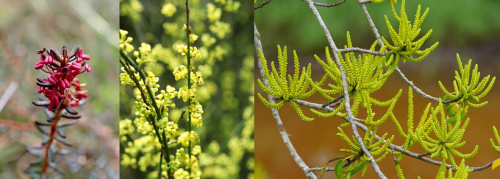
The black crowberry (Empetrum nigrum, left), osyris (Osyris alba, center) and blind-your-eye mangrove (Excoecaria agallocha, right) were part of the order Dioecia Triandria. Credits to Krzysztof Ziarnek (crowberry), Hans Hillewaert (osyris) and Wikimedia user Vengolis (blind-your-eye mangrove).
22.4 Dioecia Tetrandria (“two houses, four males”), male flowers having four stamens: Trophis (trophis), Batis (beachwort), Viscum (mistletoes), Hippophae (sea buckthorns), Myrica (bog myrtles and wax myrtles).

The beachwort (Batis maritima, left), common mistletoe (Viscum album, center-left), common sea buckthorn (Hippophae rhamnoides, center-right) and bog myrtle (Myrica gale, right) made up the order Dioecia Tetrandria. Credits to Forest & Kim Starr (beachwort), Karunakar Rayker (sea buckthorn), Sten Porse (bog myrtle) and Wikimedia user AnRo0002 (mistletoe).
22.5 Dioecia Pentandria (“two houses, five males”), male flowers having five stamens: Pistacia (pistachios and lentiscs), Zanthoxylum (prickly ashes), Ceratonia (carob tree), Iresine (Juba’s bush), Antidesma (heen embilla), Spinacia (spinach), Acnida (water hemp), Cannabis (hemp), Humulus (hop), Zanonia (zanonia), Fevillea (javillo).

The order Dioecia Pentandria included (from left to right, top to bottom) the pistachio (Pistacia vera), souther prickly ash (Zanthoxylum clava-herculis), carob tree (Ceratonia siliqua), Juba’s bush (Iresine celosia, now Iresine diffusa), spinach (Spinacia oleracea), hemp (Cannabis sativa), the common hop (Humulus lupulus), zanonia (Zanonia indica) and javillo (Fevillea cordifolia). Credits to Franz Xaver (Juba’s bush), Dinesh Valke (hemp), Fritz Geller-Grimm (hop), P. Acevedo (javillo) and Wikimedia users NAEINSUN (pistachio), Rickjpelleg (carob tree), Rasban (spinach) and Vinayaraj (zanonia).
22.6 Dioecia Hexandria (“two houses, six males”), male flowers having six stamens: Tamus (lady’s seal), Smilax (smilaxes), Rajania (rajanias), Dioscorea (true yams).
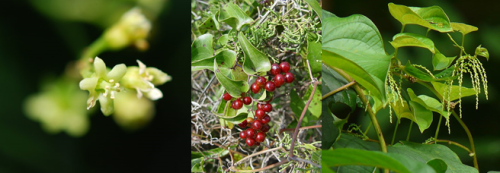
Linnaeus included the lady’s seal (Tamus communis, now Dioscorea communis, left), common smilax (Smilax aspera, center) and air yam (Dioscorea bulbifera, right) in the order Dioecia Hexandria. Credits to Alan Fryer (lady’s seal), Carsten Niehaus (smilax) and Dinesh Valke (yam).
22.7 Dioecia Octandria (“two houses, eight males”), male flowers having eight stamens: Populus (aspens and poplars), Rhodiola (golden root).
22.8 Dioecia Enneandria (“two houses, nine males”), male flowers having nine stamens: Mercurialis (mercuries), Hydrocharis (frogbits).

The order Dioecia Octandria included the common aspen (Populus tremula, left) and the golden root (Rhodiola rosea, center-left), while the order Dioecia Enneandria included the dog’s mercury (Mercurialis perennis, center-right) and the common frogbit (Hydrocharis morsus-ranae, right). Credits to Wikimedia users AnRo0002 (aspen), Amazonia Exotics U.K (golden root), BerndH (mercury) and Salicyna (frogbit).
22.9 Dioecia Decandria (“two houses, ten males”), male flowers with ten stamens: Carica (papaya tree), Kiggelaria (wild peach), Coriaria (coriarias), Datisca (datiscas).
22.10 Dioecia Polyandria (“two houses, many males”), male flowers with many stamens: Cliffortia (Cliffortias).

The order Dioecia Decandria included (from left to right) the papaya tree (Carica papaya), wild peach (Kiggelaria africana), huique (Coriaria ruscifolia) ad Asian datisca (Datisca cannabina), while the prickly cliffortia (Cliffortia ruscifolia, right) was one of the few members of the order Dioecia Polyandria. Credits to Vijayan Rajapuram (papaya tree), Franz Xaver (huique), H. Zell (datisca), and Wikimedia users JMK (wild peach) and Dwergenpaartje (cliffortia).
22.11 Dioecia Monadelphia (“two houses, single brothers”), male flowers with stamens fused in a single body by their filaments: Juniperus (junipers), Taxus (yews), Ephedra (joint pines), Cissampelos (velvetleaf), Adelia (adelias).

Among the members of the order Dioecia Monadelphia there were (from left to right) the Phoenician juniper (Juniperus phoenicea), European yew (Taxus baccata), common joint pine (Ephedra distachya) and velvetleaf (Cissampelos pareira). Credits to Isidre Blanc (juniper), Didier Descouens (yew), Dinesh Valke (velvetleaf) and Wikimedia user Le.Loup.Gris (joint pine).
22.12 Dioecia Syngenesia (“two houses, same generation”), male flowers with stamens fused into a cylinder: Ruscus (butcher’s brooms and poet’s laurel).
22.13 Dioecia Gynandria (“two houses, female husband”), male flowers with stamens united to the (sterile) pistil: Clutia (lightning bushes).
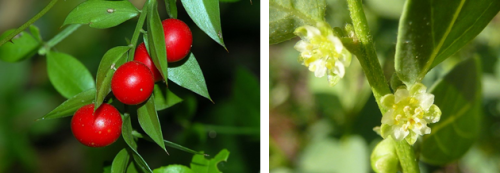
The common butcher’s broom (Ruscus aculeatus, left) was in the order Dioecia Syngenesia, and the common lightning bush (Clutia pulchella, right) was in the order Dioecia Gynandria. Credits to Fritz Geller-Grimm (butcher’s broom) and Wikimedia user JMK (lightning bush).
23. Polygamia (“many marriages”)
“Husbands with wives as well as unmarried ones live together in different bedrooms”, i.e., there are hermaphroditic flowers, as well as male-only or female-only flowers in the same species.
23.1 Polygamia Monoecia (“many marriages, single house”), hermaphrodite flowers occur in the same plant in which male-only or female-only flowers occur: Musa (banana trees), Ophioxylon (devil pepper), Celtis (hackberries), Veratrum (false hellebores), Andropogon (beard grasses, bluestems, spear grasses, lemon grasses, among others), Holcus (soft grasses, fountaingrasses, sorghums, among others), Apluda (Mauritian grass), Ischaemum (murainagrass), Cenchrus (sandspurs), Aegilops (goatgrasses), Valantia (valantias), Parietaria (pellitories), Atriplex (oraches), Dalechampia (dalechampias), Clusia (copeys), Acer (maples), Begonia (begonias), Mimosa (mimosas, shimbilloes, sennas, blackbeads, among others).
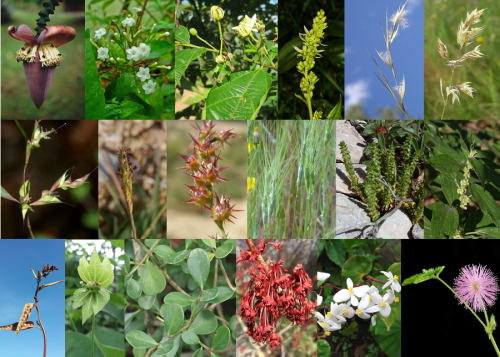
The diverse order Polygamia Monoecia included (from left to right, top to bottom) the banana tree (Musa paradisiaca, currently Musa × paradisiaca, a hybrid), devil pepper (Ophioxylon serpentinum, now Rauvolfia serpentina), Mediterraean hackberry (Celtis australis), white hellebore (Veratrum album, broomsedge bluestem (Andropogon virginicus), creeping soft grass (Holcus mollis), Mauritian grass (Apluda mutica), common murainagrass (Ischaemum aristatum), common sandspur (Cenchrus echinatus), bearded goatgrass (Aegilops triuncialis), wall valantia (Valantia muralis), upright pellitory (Parietaria officinalis), garden orache (Atriplex hortensis), common dalechampia (Dalechampia scandens), lesser copey (Clusia minor), red maple (Acer rubrum), Antillean begonia (Begonia obliqua), and touch-me-not (Mimosa pudica). Credits to Franz Xaver (banana tree), H. Zell (devil pepper), Krish Dulal (hackberry), Hedwig Storch (white hellebore), Harry Rose (bluestem), Krzysztof Ziarnek (soft grass), J. M. Garg Mauritian grass), Javier Martin (goatgrass), Radio Tonreg (pellitory), Stefan Lefnaer (orache), David J. Stang (copey), Yercaud Elango (begonia), flickr user Macleay Grass Man (sandspur) and Wikimedia users Keisotyo (murainagrass), Aroche (valantia), Aniprina (dalechampia), Famartin (maple) and Werner1122 (touch-me-not).
23.2 Polygamia Dioecia (“many marriages, two houses”), hermaphrodite flowers and male-only or female-only flowers occur in different plants: Gleditsia (locusts), Fraxinus (ashes), Diospyros (persimmon trees), Nyssa (tupelo), Anthospermum (anthosperm), Arctopus (bear foot), Pisonia (birdcatcher trees), Panax (ginseng).
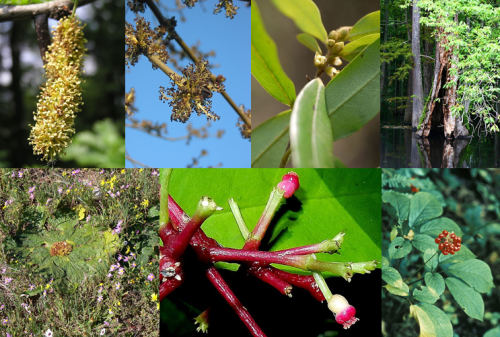
In the order Polygamia Dioecia, Linnaeus included (from left to right, top to bottom) the honey locust (Gleditsia triacanthos), common ash (Fraxinus excelsior), American persimmon (Diospyros virginiana), water tupelo (Nyssa aquatica), bear foot (Arctopus echinatus), thorny birdcatcher tree (Pisonia aculeata) and American ginseng (Panax quinquefolius). Credits to Andrew Butko (locust), Donar Reiskoffer (ash), Dinesh Valke (persimmon), Winfried Bruenken (bear foot), Alex Popvkin (birdcatcher tree), Dan J. Pittillo (ginseng) and Flickr user lucianvenutian (tupelo).
23.3 Polygamia Trioecia (“many marriages, three houses”), there are plants with only male flowers, others with only female flowers and others with both male and female flowers: Ficus (fig trees).
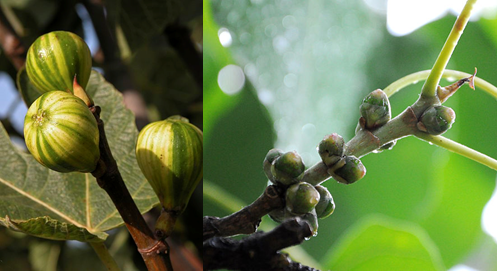
The order Polygamia Trioecia included only the genus Ficus, with species such as the common fig tree (Ficus carica, left) and the sacred fig tree (Ficus religiosa, right). Credits to Flickr user INRA DIST (common fig tree) and Wikimedia user Amada44 (sacred fig tree).
By classifying all plants with flowers of different sexualities in three classes, Linnaeus made a complete mess. We usually can see at least a vague pattern toward what was later found to be phylogenetically true in some other groups, but it is hard to find anything still relevant today here.
We only need one more part and we will finally finish Linnaeus’ system!
– – –
Reference:
Linnaeus, C. (1758) Systema Naturae per regna tria Naturae…
– – –

All images are licensed under a Creative Commons Attribution-ShareAlike 4.0 International License.




